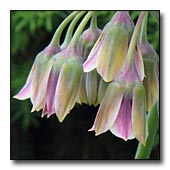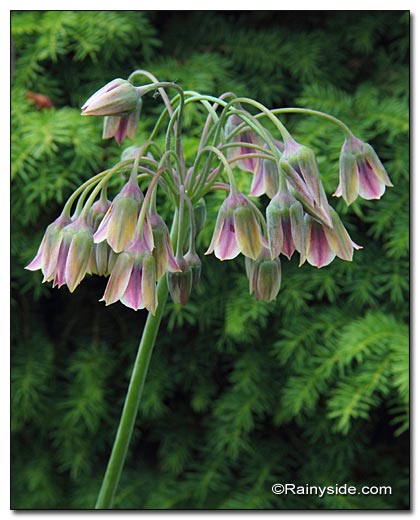Nectaroscordum siculum
SICILIAN HONEY GARLIC, MEDITERRANEAN BELLS,
SICILIAN HONEY LILY
syn. Allium bulgaricum, Allium siculum, N. dioscoridis
Family: Alliaceae
Pronounced: nek-tar-oh-SKOR-dum SIK-yoo-lum

Quick Jumps
Growing Guide
Rainy Side Notes
GROWING GUIDE

Origin:
Southeast Europe, Northwest Turkey, Ukraine, Iran.
Plant Group:
Bulbs.
Hardiness:
Sunset zones: 2B-9, 14-24.
USDA zones: 6-9.
Heat zones: 10-1.
Mature size:
Height: 12-16 inches.
Flowering period:
Late May to June.
Flowering attributes:
Four foot tall, fleshy stems carry a cluster of up to 30 nodding, 1-inch, bell-shaped flowers that are multi-colored in off-white, green, purple, and pink hues.
Leaf attributes:
Strap-like, linear 12-16 inch long leaves, that produces the fragrance of garlic when crushed or bruised.
Growth habit:
Clumping.
Light:
Partial shade to full sun.
Soil:
Well-drained soil.
Feeding:
In spring fertilize with a complete organic fertilizer.
Propagation Methods:
Sow seed in pots in autumn or spring and place in cold frame.
Remove offsets in summer and replant.
Lift and separate bulbs in late summer.
Pruning Methods:
No pruning.
Pests and Diseases:
Pest and disease free.
Rainy Side Notes
I don’t know why the nodding, versicolored flowers make me think of Neapolitan ice cream, especially since they are closely related to onions, but they do. These wonderful bulbs grow a cluster of buds, which begin upright, and as each bud opens the stems relax causing the flowers to hang down. As the flowers fade the stem goes back up, holding the seed heads high.
Once classified as an allium, its name changed to the genus of three species—Nectaroscordum. The name is derived from the Greek word nektar—the drink of the Olympian gods—and skordian—garlic. The bulb hails from Mediterranean and Western Asian regions and is perfectly suited for our Mediterranean type climate in the Pacific Northwest. When our dry season is in full session, the bulb has already gone dormant until the next growing season.
The plants may reseed, but unlike some of their allium cousins, they are not obnoxious about it. Plant new bulbs 18 inches apart and 2 inches deep. The flower stems reach 4 feet tall while the leaves are only 12 to 16 inches long. Since the leaves begin to dry out at flowering time, strategically plant the bulbs behind other plants that grow tall enough to hide the drying foliage, yet remain short enough so the blossoms aren’t hidden.
Photographed at the Goat Farm in Orting, Washington.

Gardening for the Homebrewer: Grow and Process Plants for Making Beer, Wine, Gruit, Cider, Perry, and More
By co-authors Debbie Teashon (Rainy Side Gardeners) and Wendy Tweton
Copyright Notice | Home | Search | Bulbs

